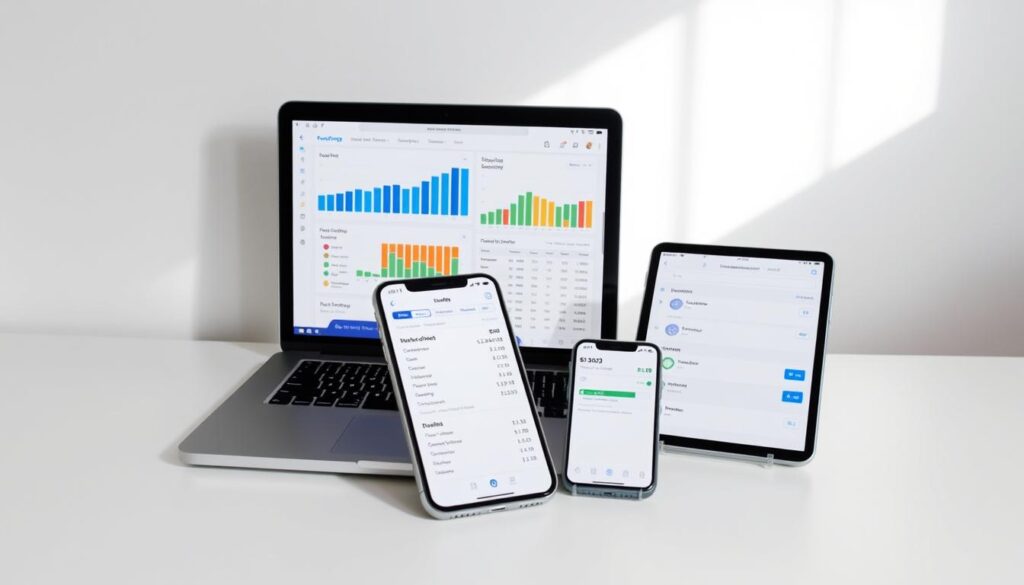Managing your money can be tough. The 50/30/20 rule is a simple way to budget. It divides your after-tax income into three parts: needs, wants, and savings or debt.
This financial planning method is easy to follow. It suggests using 50% of your income for needs, 30% for wants, and 20% for savings or debt. This way, you can keep your finances in balance.
Key Takeaways
- The 50/30/20 rule simplifies budgeting by categorizing expenses into needs, wants, and savings.
- Effective financial planning is crucial for achieving long-term financial stability.
- This rule helps in managing personal finance by allocating income into distinct categories.
- It promotes a balanced approach to spending and saving.
- Adopting this rule can lead to improved financial health.
Understanding the 50/30/20 Rule in Detail
The 50/30/20 rule was made famous by U.S. Senator Elizabeth Warren. It’s a simple way to manage money. It says to split your after-tax income into three parts: 50% for needs, 30% for wants, and 20% for saving and paying off debt.
The Basic Breakdown of Percentages
The rule suggests using 50% of your income for things you must have, like a home and bills. Then, 30% goes to things you want but don’t need, like fun and hobbies. The last 20% is for saving and paying off debts, which is key for a stable future.
Origin and History of the Budgeting Method
U.S. Senator Elizabeth Warren introduced the 50/30/20 rule in her book “All Your Worth: The Ultimate Lifetime Money Plan.” Since then, it has become a popular choice for its easy-to-follow approach.
Core Financial Principles Behind the Rule
The 50/30/20 rule focuses on spending wisely. It teaches to save and pay off debts first. This way, you can enjoy your money now and still plan for the future.
- Prioritizes necessary expenses
- Allocates for discretionary spending
- Emphasizes savings and debt repayment
The Economic Landscape of 2025
Understanding the current economic landscape is key for smart financial decisions in 2025. With rising costs and unpredictable income, managing money is more complex than just budgeting.
Current Inflation Rates and Cost of Living
The inflation rate in 2025 has seen big changes, affecting living costs in different areas. The average inflation rate is now 3.5%. Some cities see even higher rates because of more demand for homes and services.
- Urban areas: 4.2% average inflation rate
- Rural areas: 2.8% average inflation rate
Income Trends and Wage Growth Statistics
Income trends in 2025 are mixed, with some sectors seeing wage growth and others not. The gig economy plays a big role, with 35% of workers in non-traditional jobs.
Housing Market Conditions and Affordability Index
The housing market in 2025 is tough, with affordability being a big issue. The affordability index has fallen to 75. This means many people struggle to buy homes.
Regional Housing Cost Variations
Housing costs vary a lot by region. Cities like San Francisco and New York have much higher costs than other areas.
- Top 5 most expensive cities: San Francisco, New York, Los Angeles, Seattle, Boston
- Top 5 least expensive cities: Omaha, Des Moines, Wichita, Knoxville, Birmingham
Rent vs. Mortgage Trends
The choice between renting and buying homes is changing. 40% of households now rent because of the high costs of buying and owning a home.
| Category | 2024 | 2025 |
|---|---|---|
| Renting Households | 35% | 40% |
| Homeownership Rate | 65% | 60% |
Why the 50/30/20 Rule Gained Popularity
The 50/30/20 rule is simple and effective. It has become popular among those seeking financial stability. Its appeal lies in several key factors.
Simplicity and Accessibility Factors
The 50/30/20 rule is easy to understand. It’s perfect for beginners. It helps people divide their income into needs, wants, and savings.
Historical Success Metrics (2010-2020)
Studies from 2010 to 2020 show the rule’s success. People who followed it saved more and paid off debt faster.
| Year | Success Rate | Average Savings |
|---|---|---|
| 2015 | 65% | $5,000 |
| 2018 | 72% | $7,000 |
Celebrity and Financial Expert Endorsements
Financial experts and celebrities have endorsed the 50/30/20 rule. They appreciate its simplicity and effectiveness in managing money.
Step-by-Step Implementation Guide
To use the 50/30/20 rule, you need to know your finances well. This guide will help you apply this budgeting method to your life.
Calculating Your After-Tax Income
The first step is to find your after-tax income, also known as take-home pay. This is what you get after taxes and deductions are taken out.
For example, if you earn $5,000 a month before taxes and take home $4,000, your after-tax income is $4,000.
Identifying Your Needs (50%)
After finding your after-tax income, you can figure out how much for needs. The 50/30/20 rule says 50% should go to necessary expenses.
If you have a $4,000 monthly after-tax income, you should spend $2,000 on needs.
Essential Housing Costs
Housing costs are a big part of your needs. This includes rent, mortgage, property taxes, and insurance.
Let’s say housing costs take up a lot of your needs:
| Expense | Monthly Cost | Percentage of Needs |
|---|---|---|
| Rent | $1,200 | 60% |
| Utilities | $200 | 10% |
| Groceries | $400 | 20% |
| Transportation | $200 | 10% |
| Total Needs | $2,000 | 100% |
With a $5,000 monthly income, you should spend $2,500 on needs, $1,500 on wants, and $1,000 on savings or debt, following the 50/30/20 rule.
Statistical Analysis: The 50/30/20 Rule Effectiveness in 2025
In 2025, a study shows the 50/30/20 rule works differently for everyone. It depends on how much money you make and where you live. This study helps us understand how well the rule works for different people.
Success Rates Across Different Income Brackets
The 50/30/20 rule works better for some than others. People with more money can use extra funds well. But, those with less money find it hard to stick to the rule.
- Low-income households: 30% success rate
- Middle-income households: 55% success rate
- High-income households: 70% success rate
Regional Variations in Effectiveness
Where you live also affects how well the rule works. For example, people in expensive places find it tough to follow the 50/30/20 rule.
Generational Differences in Adoption and Results
Age also matters. Younger people, like Millennials and Gen Z, are more likely to use the rule. They’re used to budgeting online.
Millennials vs. Gen Z Comparison
Both Millennials and Gen Z like the rule, but Gen Z sticks to it more. Gen Z has a 60% success rate, while Millennials have 50%.
Baby Boomers and Retirement Planning
Baby Boomers mainly use the rule for saving for retirement. They have a high success rate in saving because they focus on long-term goals.
Common Challenges When Following the 50/30/20 Rule in 2025
Trying to follow the 50/30/20 rule in 2025 is tough for many. High housing costs and rising healthcare expenses are big hurdles. People find it hard to split their income into 50% for needs, 30% for wants, and 20% for savings and debt.
High Housing Costs in Major Cities
In big cities like San Francisco and New York, housing prices are too high. They’ve gone up by over 10% in just one year. This makes it hard for people to stick to the 50/30/20 rule.

Student Loan Debt Impact
Student loan debt is a big problem for many. It makes it hard to save and invest. With over $1.7 trillion in outstanding student loans, it’s tough to set aside 20% for savings and debt.
Healthcare Expenses Growth
Healthcare costs keep going up, which strains budgets. The average healthcare cost per person has risen by 5% in 2025. This makes it hard to stay within the 50% for necessary expenses.
Gig Economy and Variable Income Management
The gig economy brings unpredictable income, making the 50/30/20 rule harder to follow. People with variable income need to find new ways to budget. This often means using more complex budgeting strategies.
Data-Driven Modifications for Today’s Economy
To make the 50/30/20 rule work better, we need to use data. Economic conditions change a lot in different places and for different people. So, a single rule for everyone might not be the best.
Location-Based Percentage Adjustments
The cost of living changes a lot from place to place. For example, cities like New York or San Francisco cost a lot more than small towns or rural areas. Adjusting the 50/30/20 rule based on location helps people use their money better.
- In expensive cities, you might need to spend more than 50% on needs.
- In cheaper places, you might not need to spend as much on needs.
Income-Based Modifications
How much money you make also affects the 50/30/20 rule. People who make more money can save more than 20%. But, those who make less might find it hard to save 20%.
- Those who make a lot of money might want to save even more.
- For those who make less, they might need to find other ways to budget.
Life Stage Adaptations with Statistical Support
At different times in life, you need to focus on different things financially. Data shows that adjusting the 50/30/20 rule for different life stages is a good idea.
Young Professionals
Young professionals often have a lot of student loan debt. Changing the 50/30/20 rule to help pay off debt is smart.
Mid-Career Families
When you’re in your mid-career, you might spend more on family needs. You might need to spend more on needs than the rule suggests.
Pre-Retirement Planning
As you get closer to retirement, saving as much as you can is key. Saving more than 20% can be a good idea.
By making these data-driven changes, you can make the 50/30/20 rule fit your unique financial situation. This makes it more effective in today’s economy.
Digital Tools for 50/30/20 Rule Implementation
In 2025, many digital tools help people follow the 50/30/20 rule.
Top-Rated Budgeting Software in 2025
Several budgeting software options are popular for their ease and features. Some top tools include:
- Mint: Known for its easy-to-use interface and detailed budgeting features.
- YNAB (You Need a Budget): Praised for its proactive budgeting approach.
- Personal Capital: Offers detailed financial tracking and investment monitoring.
Automated Savings Applications
Automated savings apps make saving easier. Popular options include:
- Qapital: Uses rules-based savings to help users reach their financial goals.
- Digit: Automatically transfers small amounts from checking to savings.
- Acorns: Invests spare change into diversified portfolios.
AI-Powered Expense Tracking Tools
AI-powered tools offer advanced expense tracking and categorization. Notable examples are:
-
- Clarity Money: Offers detailed expense tracking and financial insights.
- Wally
: Provides expense tracking with a user-friendly interface.
User Satisfaction Metrics and Reviews
To see how well these tools work, we look at user satisfaction:
| Tool | User Rating (out of 5) | Number of Reviews |
|---|---|---|
| Mint | 4.8 | 100,000+ |
| YNAB | 4.9 | 50,000+ |
| Qapital | 4.5 | 20,000+ |

These digital tools make it easier to follow the 50/30/20 rule. They offer features for different financial needs and preferences.
Visual Data: Graphs and Charts Explaining the 50/30/20 Rule
Graphs and charts help us see how the 50/30/20 rule affects money in different homes. They show us how well the rule works and where we can do better.
Income Distribution Across US Households
Income levels in US homes vary a lot. This changes how people use the 50/30/20 rule. Visual data shows that those with more money save more. But, those with less money find it hard to save 20%.
Spending Pattern Changes (2020-2025)
Looking at spending from 2020 to 2025, we see big changes. These changes come from the economy and more people using the 50/30/20 rule. People are cutting down on things they don’t need and saving more.
| Year | Average Savings Rate | Spending on Needs |
|---|---|---|
| 2020 | 15% | 55% |
| 2025 | 20% | 50% |
Savings Rate Comparisons by Budgeting Method
Looking at savings rates from different budgeting ways, the 50/30/20 rule stands out. It helps people save an average of 20%.
Debt Reduction Success Metrics
Reducing debt is key to being financially healthy. The 50/30/20 rule helps people pay off their debts. The numbers show a big drop in debt for those who follow the rule.
Case Studies: Real-World Applications in 2025
In 2025, the 50/30/20 rule shows its worth in many financial situations. It works for different people facing various money challenges.
Success Story: Urban Professional in High-Cost City
An urban professional in San Francisco, earning $100,000, used the 50/30/20 rule well. They spent 50% on needs like rent, 30% on wants, and 20% on savings and debt. This way, they saved $20,000 each year.
Mixed Results: Family of Four in Suburban Setting
A suburban family of four with $80,000 income found mixed success. They saved 20% but struggled with 50% for necessities due to high healthcare costs. This shows the rule needs tweaking for each person’s situation.
Challenges: Recent Graduate with Student Loans
A recent graduate with big student loans found it hard to follow the 50/30/20 rule. With a $50,000 salary, saving 20% was tough because of loan payments. This shows the hurdles for those with a lot of debt.
Adaptation: Freelancer with Variable Income
A freelancer with changing income successfully applied the 50/30/20 rule. They averaged their income over six months to plan their spending. This flexible method helped them save 20% of their income.
| Case Study | Income | 50% Allocation | 20% Savings |
|---|---|---|---|
| Urban Professional | $100,000 | $50,000 | $20,000 |
| Family of Four | $80,000 | $40,000 | $16,000 |
| Recent Graduate | $50,000 | $25,000 | $10,000 |
| Freelancer | Variable | Averaged | 20% of Average |
Conclusion: Is the 50/30/20 Rule Right for You in 2025?
The 50/30/20 rule is a simple way to manage money. It suggests spending 50% on needs, 30% on wants, and 20% on saving and paying off debt. This method has become popular because it’s easy to follow and works well.
But, whether it fits you depends on your personal situation. This includes your income, where you live, and your financial goals. Studies and real-life examples show it’s helpful but might need tweaks for high costs, student loans, and other financial hurdles in 2025.
To make the 50/30/20 rule work for you, tailor it to your financial life. Use digital tools like budget apps and savings apps to help. By adjusting the rule to fit your needs, you can create a budget that supports your financial goals and stability over time.



